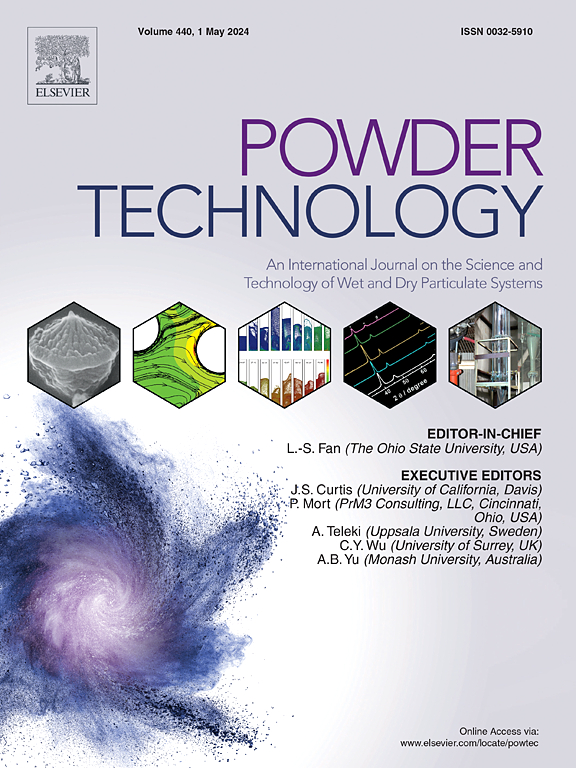压实模拟中材料和工艺参数对修正系数Kp的影响
IF 4.5
2区 工程技术
Q2 ENGINEERING, CHEMICAL
引用次数: 0
摘要
人们普遍认为,压实模拟器可以模拟压实机的单轴压缩过程。校正因子(Kp)是一个参数,用于调整压实模拟的数学模型,以获得相同的产品相对密度,因此考虑到机械和规模中的特定变量。然而,Kp通常是在有限的设计空间内为单一材料建立的。本研究探讨了轧辊压实模拟过程中材料和工艺参数如轧辊速度、轧辊间隙和比压实力(SCF)对Kp的影响。以MCC、淀粉和两种材料50:50的共混物为模型材料进行研究。利用密度测量法测量了带状和带状的相对密度,利用相对密度的比值计算确定了Kp。轧辊速度对Kp的影响具有统计学意义(p <;淀粉的差异无统计学意义(p > 0.05),而MCC和MCC:Starch的差异无统计学意义(p >;0.05)。此外,发现轧制间隙对Kp的影响具有统计学意义(p <;0.05)。发现SCF对淀粉Kp的影响具有统计学意义(p <;0.05),而MCC和MCC:Starch: 50%的影响无统计学意义(p >;0.05)。此外,间隙和材料的综合影响也具有统计学显著性(p <;0.05)效应导致二阶组合效应。SCF、辊间隙和材料性能的相互作用影响Kp,表明在确定不同配方的Kp时需要定制方法。本文章由计算机程序翻译,如有差异,请以英文原文为准。

Influence of material and process parameters on the correction factor Kp in roller compaction simulation
It is widely believed that compaction simulators can replicate the uniaxial compression process of a roller compactor. The correction factor (Kp) is a parameter used to adjust a mathematical model for compaction simulation to obtain the same product relative density, therefore accounting for specific variables in machinery and scale up. However, the Kp has often been established for a single material and within a limited design space. This study investigates the impact of material and process parameters such as roll speed, roll gap and specific compaction force (SCF) on the Kp during roller compaction simulation. MCC, Starch and a 50:50 % blend of the two materials were used as model materials for the investigation. The relative densities from ribbons and riblets were measured using pycnometry and Kp was determined using ratio calculation of the respective relative densities. The influence of roll speed on Kp was found to be statistically significant (p < 0.05) for Starch, however the same influence was not statistically significant for MCC and MCC:Starch 50 %:50 % (p > 0.05). Furthermore, the influence of roll gap on Kp was found to be statistically significant (p < 0.05) for all three materials. The influence of the SCF on the Kp was found to be statistical significant for Starch (p < 0.05), however the same influence was not statistically significant for MCC and MCC:Starch 50 %:50 % (p > 0.05). In addition, the combined influence of the gap and material exhibits also a statistically significant (p < 0.05) effect based on Kp leading to a second-order combined effect. The interaction of SCF, roll gap, and material properties affecting Kp, indicates the need for a tailored approach when determining Kp for different formulations.
求助全文
通过发布文献求助,成功后即可免费获取论文全文。
去求助
来源期刊

Powder Technology
工程技术-工程:化工
CiteScore
9.90
自引率
15.40%
发文量
1047
审稿时长
46 days
期刊介绍:
Powder Technology is an International Journal on the Science and Technology of Wet and Dry Particulate Systems. Powder Technology publishes papers on all aspects of the formation of particles and their characterisation and on the study of systems containing particulate solids. No limitation is imposed on the size of the particles, which may range from nanometre scale, as in pigments or aerosols, to that of mined or quarried materials. The following list of topics is not intended to be comprehensive, but rather to indicate typical subjects which fall within the scope of the journal's interests:
Formation and synthesis of particles by precipitation and other methods.
Modification of particles by agglomeration, coating, comminution and attrition.
Characterisation of the size, shape, surface area, pore structure and strength of particles and agglomerates (including the origins and effects of inter particle forces).
Packing, failure, flow and permeability of assemblies of particles.
Particle-particle interactions and suspension rheology.
Handling and processing operations such as slurry flow, fluidization, pneumatic conveying.
Interactions between particles and their environment, including delivery of particulate products to the body.
Applications of particle technology in production of pharmaceuticals, chemicals, foods, pigments, structural, and functional materials and in environmental and energy related matters.
For materials-oriented contributions we are looking for articles revealing the effect of particle/powder characteristics (size, morphology and composition, in that order) on material performance or functionality and, ideally, comparison to any industrial standard.
 求助内容:
求助内容: 应助结果提醒方式:
应助结果提醒方式:


